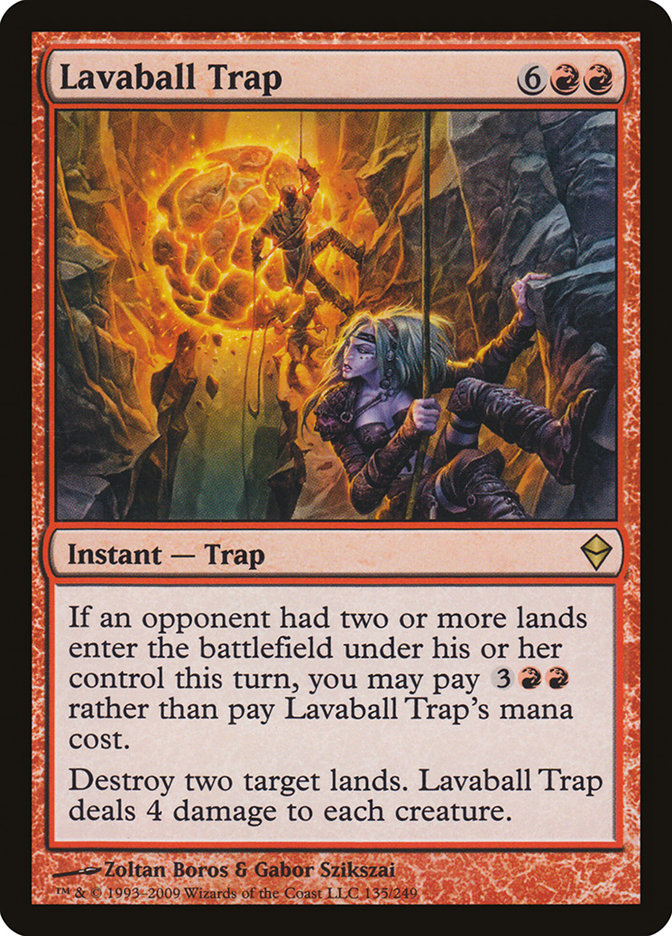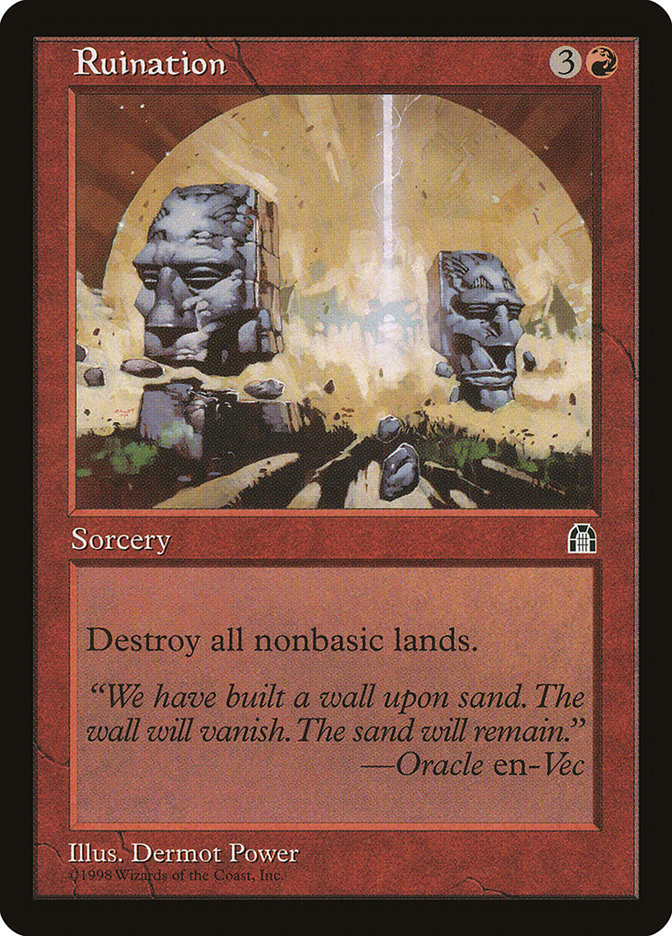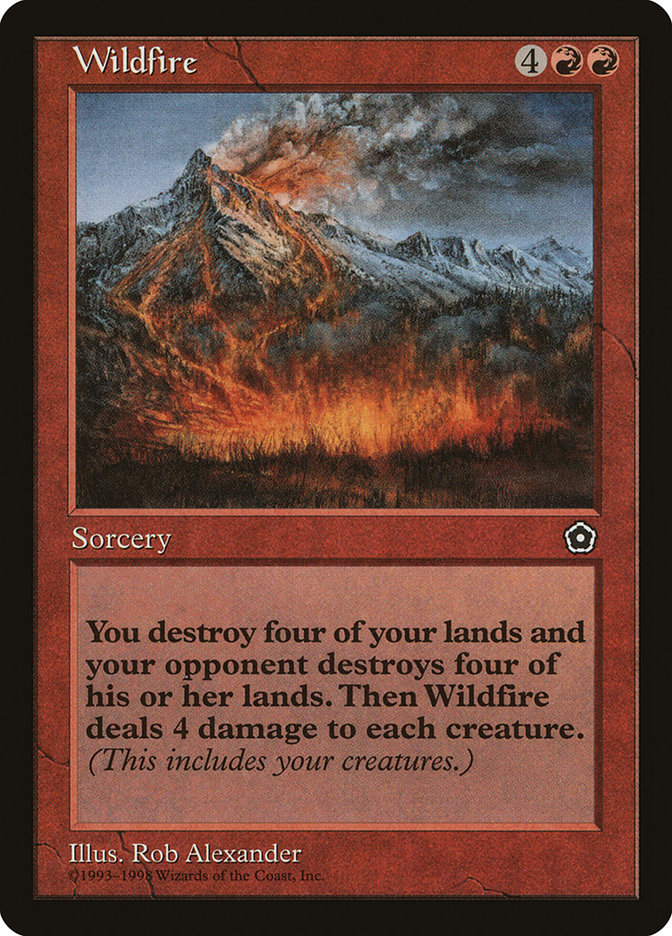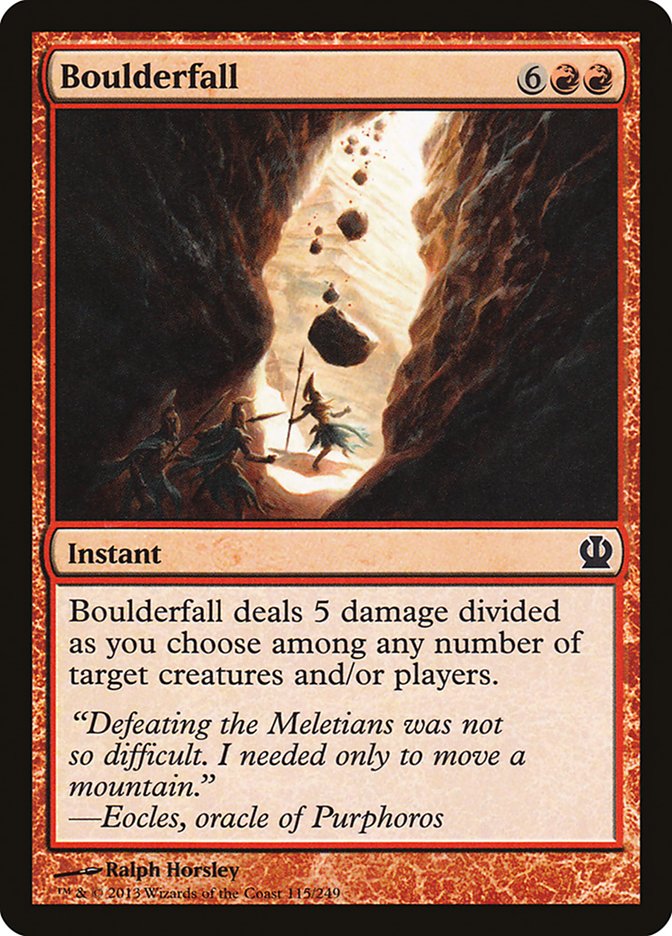Lavaball Trap MTG Card
| Mana cost | |
| Converted mana cost | 8 |
| Rarity | Rare |
| Type | Instant — Trap |
| Released | 2009-10-02 |
| Set symbol | |
| Set name | Zendikar |
| Set code | ZEN |
| Number | 135 |
| Frame | 2003 |
| Layout | Normal |
| Border | Black |
| Illustred by | Zoltan Boros & Gabor Szikszai |
Text of card
If an opponent had two or more lands enter the battlefield under his or her control this turn, you may pay rather than pay Lavaball Trap's mana cost. Destroy two target lands. Lavaball Trap deals 4 damage to each creature.
Cards like Lavaball Trap
Lavaball Trap offers a distinctive blend of removal and land disruption within MTG, reminiscent of cards like Ruination. While Ruination destroys all nonbasic lands, Lavaball Trap selectively targets two lands and has the added bonus of sweeping away smaller creatures. However, it does come with a steep mana cost that’s mitigated under specific conditions. In comparison, we find Wildfire which not only decimates lands but also damages each creature. Wildfire, though less conditional, affects all players equally and doesn’t offer the trap’s potential cost reduction.
Another card that shares the land destruction theme is Volcanic Offering. Like Lavaball Trap, it provides the ability to set back opponents’ mana bases. Yet, Volcanic Offering offers more flexibility, allowing the destruction of nonland permanents and presenting instant-speed interaction while remaining independent from opponents’ actions. Conversely, Craterize sits in a simpler spot, straightforwardly destroying a single land without additional effects, but it has the advantage of a lower, more accessible cost than Lavaball Trap.
As players evaluate their red control options, Lavaball Trap stands out with its potential for a reactionary playstyle and a substantial impact on the board, assuming the set-up is right. It’s a significant inclusion in decks that aim to hinder opponents’ strategies through land and creature control.
Cards similar to Lavaball Trap by color, type and mana cost
Card Pros
Card Advantage: Lavaball Trap offers a unique approach to card advantage. While it may not directly draw you cards, the ability to potentially sweep away multiple opponent’s permanents with a single spell can swing the game’s momentum and effectively reduce the resources at your opponent’s disposal. It provides a distinct form of card advantage by disrupting the quality of your opponent’s field rather than the quantity in your hand.
Resource Acceleration: Lavaball Trap can act as an indirect source of resource acceleration. By setting your opponent back several turns and removing critical lands or permanents, you gain a relative increase in resources compared to your opponent. This can give you the needed time to develop your board and outpace the opponent in the subsequent turns.
Instant Speed: One of the strengths of Lavaball Trap is its capacity to be cast at instant speed. This feature allows players to wait for the optimal moment to disrupt the opponent’s strategies or to respond to an overwhelming threat, all without compromising the player’s ability to act during their own turn. Reacting to your opponent’s moves at the end of their turn can yield a considerable advantage, making Lavaball Trap a versatile tool in any red controller’s arsenal.
Card Cons
Discard Requirement: One overlooked aspect of the Lavaball Trap card is the reliance on an opposing player to have activated a land ability. If this condition is not met, you’re left holding onto a card that can’t be utilized to its full potential, thus stalling your gameplay strategy.
Specific Mana Cost: Requiring a hefty amount of red mana, Lavaball Trap can be challenging to cast, particularly in decks that diversify their mana base. For players not running a mono-red or heavily red-leaning deck, this card may sit idle, waiting for the right mana combination to come into play.
Comparatively High Mana Cost: With a casting cost that includes six mana, two of which must be red, Lavaball Trap is on the expensive side. Especially in a format where speed can be critical, the investment may not always be justified, given that there are alternatives with lower casting costs or more immediate impacts on the game.
Reasons to Include in Your Collection
Versatility: Lavaball Trap offers a disruptive presence in any red deck focused on controlling the board. Its ability to not only deal damage but also return lands to an opponent’s hand gives you a significant edge against multicolored or mana-heavy strategies.
Combo Potential: Integrating with land destruction or bounce effects, Lavaball Trap synergizes well in decks that manipulate land count. Triggering its cheaper cost becomes easier, paving the way for devastating combos that set your opponent far behind.
Meta-Relevance: As players often employ numerous nonbasic lands to fine-tune their mana bases, Lavaball Trap gains relevance. It contends well against decks that rely on such lands, potentially hindering or even disrupting key plays in the current competitive scene.
How to Beat Lavaball Trap
Dealing with Lavaball Trap requires an understanding of its trigger conditions in Magic: The Gathering. Primarily, it activates if an opponent has two or more lands come into play under their control in a single turn. The key to countering this is pacing your land plays or using instant speed land destruction spells after Lavaball Trap’s conditions are met to make it more challenging to cast due to its high mana cost. Additionally, countermagic can effectively negate this red sorcery, protecting your land base from being decimated.
Players should also consider running fewer nonbasic lands, as Lavaball Trap targets those specifically. By focusing more on basic lands, the impact of Lavaball Trap is minimized. Moreover, keeping mana open for abilities or spells that can counter act destructive spells helps maintain a secure board state against this trap. Special attention should be given to conserving resources to afford the cost of countermeasures when threats such as Lavaball Trap loom on the horizon.
Ultimately, strategically navigating land placement, staying proactive with responses, and careful mana management can help mitigate the threat of Lavaball Trap, preserving your valuable lands during the intense matches of Magic: The Gathering.
Where to buy
If you're looking to purchase Lavaball Trap MTG card by a specific set like Zendikar, there are several reliable options to consider. One of the primary sources is your local game store, where you can often find booster packs, individual cards, and preconstructed decks from current and some past sets. They often offer the added benefit of a community where you can trade with other players.
For a broader inventory, particularly of older sets, online marketplaces like TCGPlayer, Card Kingdom and Card Market offer extensive selections and allow you to search for cards from specific sets. Larger e-commerce platforms like eBay and Amazon also have listings from various sellers, which can be a good place to look for sealed product and rare finds.
Additionally, Magic’s official site often has a store locator and retailer lists for finding Wizards of the Coast licensed products. Remember to check for authenticity and the condition of the cards when purchasing, especially from individual sellers on larger marketplaces.
Below is a list of some store websites where you can buy the Lavaball Trap and other MTG cards:
 BUY NOW
BUY NOW BurnMana is an official partner of TCGPlayer
- eBay
- Card Kingdom
- Card Market
- Star City Games
- CoolStuffInc
- MTG Mint Card
- Hareruya
- Troll and Toad
- ABU Games
- Card Hoarder Magic Online
- MTGO Traders Magic Online
See MTG Products
Legalities
Magic the Gathering formats where Lavaball Trap has restrictions
| Format | Legality |
|---|---|
| Commander | Legal |
| Legacy | Legal |
| Modern | Legal |
| Oathbreaker | Legal |
| Vintage | Legal |
| Duel | Legal |
| Predh | Legal |
| Penny | Legal |
Rules and information
The reference guide for Magic: The Gathering Lavaball Trap card rulings provides official rulings, any errata issued, as well as a record of all the functional modifications that have occurred.
| Date | Text |
|---|---|
| 2009-10-01 | All creatures are dealt damage, not just ones controlled by the targeted lands’ controller(s). |
| 2009-10-01 | Casting a Trap by paying its alternative cost doesn’t change its mana cost or converted mana cost. The only difference is the cost you actually pay. |
| 2009-10-01 | Effects that increase or reduce the cost to cast a Trap will apply to whichever cost you chose to pay. |
| 2009-10-01 | If both targeted lands are illegal targets by the time Lavaball Trap resolves, the entire spell doesn’t resolve. No creatures are dealt damage. |
| 2009-10-01 | You may ignore a Trap’s alternative cost condition and simply cast it for its normal mana cost. This is true even if its alternative cost condition has been met. |
| 2009-10-01 | You may target any two lands, not just ones that entered the battlefield this turn. |







